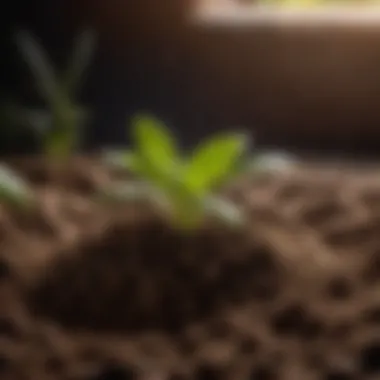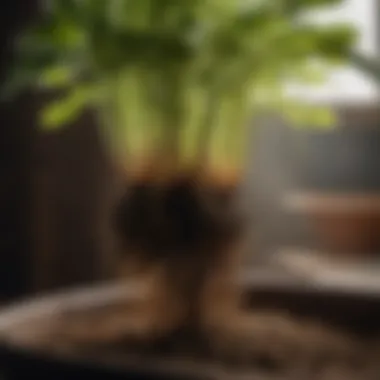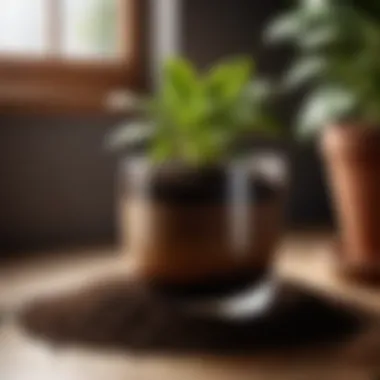Expert Guide to Choosing the Perfect Potting Soil for Indoor Plants


Materials:
- Potting Mix: 5 liters of high-quality potting mix rich in organic matter to promote healthy plant growth. Look for a mix specifically formulated for indoor plants, ensuring proper drainage and aeration.
- Perlite: 2 liters of perlite for improving soil drainage and preventing compaction, essential for maintaining root health.
- Peat Moss: 1 liter of peat moss to enhance moisture retention in the soil and provide a favorable environment for root development.
- Vermiculite: 1 liter of vermiculite to aid in moisture retention and ensure proper aeration within the soil for optimal plant growth.
- Fertilizer: Choose a balanced, slow-release indoor plant fertilizer to provide essential nutrients for robust growth.
DIY Steps:
- Selecting the Potting Mix: Begin by choosing a high-quality potting mix suitable for indoor plants, ensuring it contains the right blend of nutrients for optimal growth.
- Adding Amendments: Mix perlite, peat moss, and vermiculite into the potting mix. The perlite aids in drainage, the peat moss retains moisture, and the vermiculite improves aeration.
- Incorporating Fertilizer: Blend the slow-release indoor plant fertilizer into the potting mix, following the manufacturer's instructions for proper application.
- Testing Soil Mixture: After combining all ingredients, test the soil mixture's consistency by squeezing a handful – it should hold together loosely and not form a solid clump.
Technical Aspects:
- Tools: Utilize a large mixing container, gardening gloves, and a trowel for blending the potting mix and other amendments.
- Timing Specifics: Allow sufficient time for mixing the soil thoroughly to ensure even distribution of nutrients and amendments.
- Critical Techniques: Pay attention to the ratio of amendments added to the potting mix, as each plays a crucial role in creating a well-balanced soil mixture.
DIY Project Process:
- Mixing the Soil: Combine the potting mix, perlite, peat moss, vermiculite, and fertilizer in a large container, ensuring all components are evenly distributed.
- Filling the Pots: Fill your indoor plant pots with the prepared soil mixture, leaving ample space at the top for watering and root growth.
- Planting Indoor Plants: Gently transplant your indoor plants into the pots filled with the nutrient-rich soil mixture, taking care not to disturb the roots.
- Watering and Maintenance: Water your plants accordingly, allowing excess water to drain to prevent waterlogging, and monitor plant growth and health regularly.
Troubleshooting Tips:
- Poor Drainage: If the soil mixture retains too much water, increase the ratio of perlite for improved drainage.
- Nutrient Deficiency: Should plants show signs of yellowing leaves, consider adjusting the fertilizer application or opting for a more nutrient-rich mix.
Understanding Potting Soil for Indoor Plants
As we delve into the world of indoor gardening, the significance of selecting the appropriate potting soil becomes paramount. Understanding the intricacies of potting soil for indoor plants is not merely a matter of choice but a fundamental aspect that influences the health, growth, and overall well-being of your beloved green companions. When it comes to indoor plants, the soil acts as the foundation, determining factors such as moisture retention, drainage capacity, aeration levels, and nutrient availability. By gaining a deep understanding of potting soil characteristics and dynamics, you equip yourself with the knowledge essential for fostering lush, thriving indoor greenery.
Key Considerations for Choosing Potting Soil


Plant Species and Requirements
Delving into the specifics of plant species and their unique requirements is crucial when selecting potting soil. Different plants have varying needs, ranging from moisture preferences to nutrient requirements. Understanding the specific attributes of plant species allows you to tailor your choice of potting soil to meet these demands effectively. By aligning the soil composition with the plant's requirements, you create a conducive environment for robust growth and optimal development. Moreover, matching your plant species with the right potting soil sets the foundation for a flourishing indoor garden, ensuring that each plant receives the care and support it deserves.
Moisture Retention
Moisture retention is a critical factor to consider when choosing potting soil for indoor plants. The ability of the soil to retain adequate moisture levels directly impacts the hydration needs of your plants. Opting for a potting mix that strikes a balance between moisture retention and drainage is pivotal in preventing issues such as overwatering or underwatering. By selecting a soil blend with optimal moisture retention properties, you create a stable environment that supports healthy root development and overall plant vitality.
Drainage
Efficient drainage is a key element in potting soil selection, ensuring the proper movement of water through the soil substrate. Adequate drainage is vital in preventing waterlogging, which can lead to root rot and other moisture-related plant ailments. Choosing a potting mix with excellent drainage characteristics promotes aeration and prevents water accumulation, fostering a conducive environment for root health and microbial balance within the soil ecosystem.
Aeration
Aeration plays a vital role in maintaining soil structure and facilitating oxygen flow to the plant roots. Proper aeration ensures that the soil remains loose and well-structured, allowing for root penetration and nutrient absorption. Selecting a potting mix that promotes aeration is essential for fostering robust root systems and enhancing overall plant resilience. By prioritizing soil blends that offer sufficient aeration, you create an environment that supports optimal plant growth and vigor.
Nutrient Content
The nutrient content of potting soil directly impacts the overall health and nutritional status of indoor plants. A well-balanced soil mix that provides essential nutrients in the right proportions is essential for supporting plant growth, flowering, and fruiting. Opting for a potting soil blend rich in organic matter and micronutrients ensures that your indoor plants have access to the elements necessary for thriving. By considering the nutrient content of the soil, you lay the foundation for a nutrient-rich growing medium that fosters robust plant development and longevity.
Quality Indicators of Potting Soil
Texture and Composition
Sandy, Loamy, or Clay Soil
Delving into the texture and composition of potting soil unveils the significance of sandy, loamy, or clay soil variations in indoor plant cultivation. Each type offers unique benefits, with sandy soil providing excellent drainage, loamy soil retaining moisture effectively, and clay soil offering robust structural support to plant roots. Understanding the key characteristic of each soil type helps in selecting the most suitable option for your indoor plants.


Organic Matter Content
The organic matter content in potting soil plays a vital role in enhancing nutrient availability and promoting beneficial microbial activity. Opting for a potting mix rich in organic matter improves soil structure, supports root development, and aids in moisture retention. It is a popular choice among indoor plant enthusiasts due to its ability to create a fertile environment that fosters healthy plant growth.
Presence of Additives
Considering the presence of additives in potting soil is crucial for optimizing plant health. Additives such as perlite for aeration, vermiculite for moisture retention, or compost for nutrient enrichment can elevate the overall quality of the soil mix. While additives offer benefits like improved drainage and enhanced nutrient uptake, it is essential to balance their presence to avoid over-fertilization or waterlogged conditions in indoor plant pots.
Pest and Pathogen Control
Sterilization Methods
Exploring various sterilization methods illuminates the effectiveness of techniques like heat sterilization or chemical treatments in eliminating harmful pests and pathogens from potting soil. Sterilization safeguards your indoor plants from diseases and infestations, ensuring a healthy growing environment. The unique feature of sterilization methods lies in their ability to maintain soil cleanliness and prevent the spread of harmful microorganisms, contributing to the long-term well-being of indoor plants.
Prevention of Contamination
Emphasizing the prevention of contamination in potting soil management underscores the importance of practicing good hygiene and sanitation measures. Contamination prevention strategies include using clean gardening tools, sterilizing containers, and selecting high-quality soil mixes from reputable sources. By preventing contamination, you create a safe and healthy haven for your indoor plants to thrive, minimizing the risks of disease outbreaks and growth impediments.
Sustainability and Environmental Impact
Eco-Friendly Options
Incorporating eco-friendly options in potting soil selection aligns with sustainable gardening practices that aim to reduce environmental impact. Opting for organic, biodegradable, or locally sourced potting mixes promotes eco-conscious choices that benefit both indoor plants and the environment. The key characteristic of eco-friendly options lies in their minimal carbon footprint and biodegradability, emphasizing a holistic approach to indoor plant care that harmonizes with nature.
Recyclable Materials
Diving into recyclable materials sheds light on innovative solutions that repurpose waste products into functional potting soil components. Utilizing recyclable materials like recycled paper, coconut husks, or biodegradable plastics minimizes waste generation and contributes to a circular economy in indoor gardening. The unique feature of recyclable materials lies in their adaptability, offering sustainable alternatives that reduce environmental strain while promoting creative reuse in indoor plant cultivation.


Choosing the Best Potting Soil for Specific Plant Needs
In this article, the focus shifts towards tailoring potting soil choices to the specific requirements of various plant species. Understanding the diverse needs of plants is essential for ensuring optimal growth and health within indoor environments. By delving into the nuanced demands of different plants, enthusiasts can curate the ideal growing medium for their beloved green companions.
Cacti and Succulents
Well-Draining Mixes
The importance of well-draining mixes cannot be overstated when it comes to cultivating cacti and succulents. These desert dwellers thrive in arid conditions, necessitating soil that quickly drains excess moisture to prevent root rot. Well-draining mixes, typically composed of gritty sand and perlite, promote aeration and prevent waterlogging, mimicking natural desert soils. Their sandy texture allows water to pass through rapidly, safeguarding these plants from damp conditions that could compromise their vitality.
Low Nutrient Content
Cacti and succulents flourish in environments with low nutrient content in the soil. Excessive nutrients can lead to rapid growth, causing the plants to become leggy and lose their compact form. Low-nutrient soil encourages slow, controlled growth, promoting healthy development and structural integrity. By selecting potting mixes with minimal nutrient levels, enthusiasts can ensure that their cacti and succulents maintain their characteristic shapes and vibrant colors, reflecting their natural habitat conditions.
Tropical Plants
Moisture-Retentive Mixes
Tropical plants, originating from humid regions, require soil that retains moisture to mimic their native habitats. Moisture-retentive mixes, often incorporating coconut coir and vermiculite, provide the necessary hydration levels for these lush green wonders. The porous nature of these mixes allows them to hold onto water without becoming waterlogged, striking a delicate balance between moisture retention and aeration. This characteristic enables tropical plants to thrive, promoting robust growth and lush foliage within indoor spaces.
Balanced Nutrient Levels
Ensuring balanced nutrient levels in potting soil is crucial for the optimal growth of tropical plants. These plants rely on a consistent supply of essential nutrients to support their blooming cycles and vibrant leaf colors. Balanced nutrient levels prevent deficiencies or excesses that could hinder plant health, fostering a harmonious environment for tropical species to flourish. By selecting potting mixes with balanced nutrient profiles, enthusiasts can provide their tropical plants with the nutrients they need to thrive year-round, enhancing the beauty and vibrancy of their indoor garden.
Herbs and Vegetables
Nutrient-Rich Soil
Herbs and vegetables demand nutrient-rich soil to support their rapid growth and prolific harvests. Rich in organic matter and nutrients, these soils provide a fertile foundation for cultivating an array of culinary delights. Nutrient-rich soil offers plants the essential building blocks for robust growth, ensuring healthy foliage, abundant blooms, and flavorful produce. Enthusiasts can optimize the growth of their herbs and vegetables by selecting potting soil that is teeming with vital nutrients, fostering a bountiful and thriving garden.
Good Drainage
Good drainage is essential for herbs and vegetables to prevent waterlogged conditions that can stunt growth and promote root diseases. Soil with excellent drainage properties allows excess water to swiftly exit the root zone, maintaining optimal moisture levels for plant growth. Adequate drainage also facilitates oxygen circulation within the soil, safeguarding root health and enhancing nutrient uptake. By opting for potting mixes with superior drainage capabilities, enthusiasts can cultivate a flourishing herb and vegetable garden, setting the stage for a fruitful and rewarding harvest.







